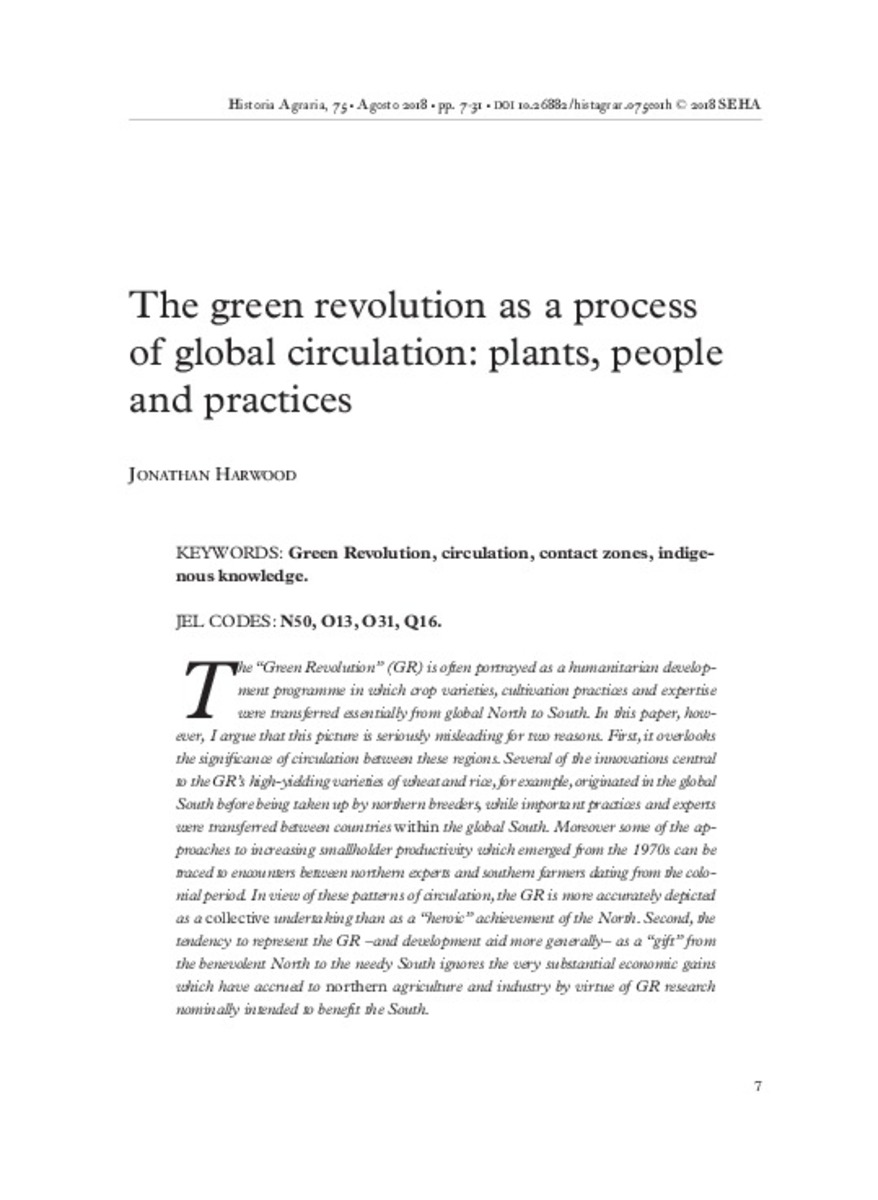Mostrar el registro sencillo del ítem
The green revolution as a process of global circulation: plants, people and practices
| dc.contributor.author | Harwood, Jonathan | |
| dc.date.accessioned | 2018-06-18T10:22:33Z | |
| dc.date.available | 2018-06-18T10:22:33Z | |
| dc.date.issued | 2018-08 | |
| dc.identifier.issn | 1139-1472 | |
| dc.identifier.uri | http://hdl.handle.net/10234/175244 | |
| dc.description.abstract | The “Green Revolution” (GR) is often portrayed as a humanitarian development programme in which crop varieties, cultivation practices and expertise were transferred essentially from global North to South. In this paper, however, I argue that this picture is seriously misleading for two reasons. First, it overlooks the significance of circulation between these regions. Several of the innovations central to the GR’s high-yielding varieties of wheat and rice, for example, originated in the global South before being taken up by northern breeders, while important practices and experts were transferred between countries within the global South. Moreover, some of the approaches to increasing smallholder productivity which emerged from the 1970s can be traced to encounters between northern experts and southern farmers dating from the colonial period. In view of these patterns of circulation, the GR is more accurately depicted as a collective undertaking than as a “heroic” achievement of the North. Second, the tendency to represent the GR –and development aid more generally– as a “gift” from the benevolent North to the needy South ignores the very substantial economic gains which have accrued to northern agriculture and industry by virtue of GR research nominally intended to benefit the South | ca_CA |
| dc.description.abstract | Es frecuente que se presente la Revolución Verde (RV) como un programa de desarrollo humanitario que supuso la transferencia de variedades vegetales, técnicas de cultivo y conocimiento desde el norte hacia el sur. En este artículo, sin embargo, argumento que esta es una imagen falsa, por dos motivos. Primero, porque ignora la importancia de los fenómenos de circulación entre aquellas regiones. Algunas de las innovaciones más importantes de la RV, por ejemplo aquellas que permitieron la obtención de variedades altamente productivas de trigo y arroz, tuvieron su origen en el sur, antes de ser adoptadas por investigadores del norte. Del mismo modo, dentro del propio sur existían redes activas de circulación de prácticas y expertos. Tanto es así, que el origen de muchas de las prácticas puestas en funcionamiento en la década de 1970, para incrementar los rendimientos de pequeños propietarios, puede remontarse hasta los primeros intercambios de información entre expertos del norte y agricultores del sur durante la época colonial. Teniendo en cuenta estos patrones de circulación, es pues más adecuado presentar la RV como un proyecto colectivo que como una acción heroica por par te del norte. En segundo lugar, la tendencia a presentar la RV –y la ayuda al desarrollo en general– como un «regalo» del norte al necesitado sur, ignora los grandes beneficios económicos obtenidos por los sectores agrícola e industrial del norte como consecuencia de la RV, que era supuestamente un mecanismo concebido para el beneficio de los países del sur. | ca_CA |
| dc.format.extent | 25 p. | ca_CA |
| dc.format.mimetype | application/pdf | ca_CA |
| dc.language.iso | eng | ca_CA |
| dc.publisher | Sociedad Española de Historia Agraria (SEHA) | ca_CA |
| dc.relation.isPartOf | Historia agraria: Revista de agricultura e historia rural, nº 75, 7-31 | ca_CA |
| dc.rights | © 2018 SEHA | ca_CA |
| dc.rights | Attribution-NonCommercial-NoDerivatives 4.0 Internacional | * |
| dc.rights.uri | http://creativecommons.org/licenses/by-nc-nd/4.0/ | * |
| dc.subject | Green Revolution | ca_CA |
| dc.subject | Revolución Verde | ca_CA |
| dc.subject | Circulation | ca_CA |
| dc.subject | Circulación | ca_CA |
| dc.subject | contact zones | ca_CA |
| dc.subject | zonas de contacto | ca_CA |
| dc.subject | indigenous knowledge | ca_CA |
| dc.subject | saberes indígenas | ca_CA |
| dc.title | The green revolution as a process of global circulation: plants, people and practices | ca_CA |
| dc.type | info:eu-repo/semantics/article | ca_CA |
| dc.subject.jel | N50 | ca_CA |
| dc.subject.jel | O13 | ca_CA |
| dc.subject.jel | O31 | ca_CA |
| dc.subject.jel | Q16 | ca_CA |
| dc.identifier.doi | http://dx.doi.org/10.26882/histagrar.075e01h | |
| dc.rights.accessRights | info:eu-repo/semantics/openAccess | ca_CA |
| dc.relation.publisherVersion | http://www.historiaagraria.com/numero.php?n=75 | ca_CA |








